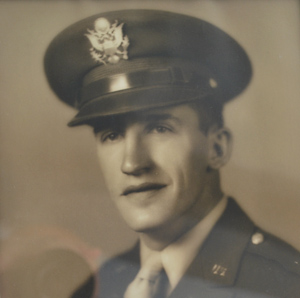
Courtesy C. Clayton Stemple Jr.

Remember...
Cecil Clayton Stemple
1918-1945
"In War: Resolution. In Defeat: Defiance. In Victory: Magnanimity. In Peace: Good Will."
Sir Winston Churchill
 Courtesy C. Clayton Stemple Jr. |
Remember...Cecil Clayton Stemple
|
Cecil Clayton Stemple was born January 14, 1918, in Ashley, Doddridge County, to Clyde and Coral Stemple. According to the 1920 Federal Census, Mr. Stemple was a stave manufacturer in Wetzel County. Though the handwritten word in the Census isn't entirely clear, this occupation is consistent with the family business in timbering and industrial wood production for the mining industry. The book The Mining American, Vol. 69, describes how staves, which were strips of wooden planks or vertical poles, were used in the mining industry (1914, pp. 46 and following). Though research did not reveal exactly how the Stemple staves were used, according to the cited book and others like it published during the era, staves could be treated, bound together into cylinders, and used as ore chutes and other vessels. Depending on the wood used and the manner of treatment, such vessels resisted rot and destruction in the harsh mining environments. Thus, stave-making was a critical business in West Virginia.
In 1930, the census taker recorded that Mr. Stemple was working as a lumberman in a sawmill in Bedford, Pennsylvania. In 1940, the census taker found Mr. Stemple was a supervisor working in the timber industry. The family, in addition to Mrs. Stemple, then included Theodore, Vivienne, Clyde Jr., Mildred, and Cecil.
Cecil Stemple graduated from Bruceton Mills High School in 1936. In December of 1940, he married Betty June Hoag, fellow West Virginian from Martinsburg. The couple met when both were students at Potomac State College and living in Keyser from 1938 through 1940. Cecil Stemple graduated with a two-year business administration degree. He registered for the draft on December 12, 1940, at Albright, Preston County, West Virginia, at which time he stated he was employed by Stemple and Stemple. He enlisted on January 6, 1941, in Morgantown, West Virginia. According to U.S. World War II Army Enlistment Records, 1938-1946, he'd had two years of a college education, and his civilian occupation was as a stenographer or typist. In the military, Cecil Stemple's rank was a private in the National Guard, and his branch was the medical department.
From enlistment, Cecil Stemple was often on the move. He first went to Fort Benjamin Harrison, just outside of Indianapolis, Indiana. Then, in September 1941, he served at Fort Greeley on Kodiak Island, Alaska. There, he fought the Japanese when they attempted an incursion into the Aleutian Islands.
Cecil spent approximately two months in Seattle before going to Camp Wheeler in Macon, Georgia, where his son, C. Clayton Jr., was born. From there he was sent to Camp McCoy near Racine, Wisconsin. While in the United States, he served with the 201st Infantry but was later assigned to the 417th Infantry, 76th Division of the Third Army, which was commanded by General Patton.
On December 1, 1944, he was sent to Monmouth, England, and then to France. From Warmeriville, France, the 417th moved to Mierchamps, Belgium, and on to Luxembourg for the final assault on Germany.
Consistent with information provided by Cecil Stemple's family in the West Virginia Veteran's Memorial listing application and in an August 2018 interview with C. Clayton Stemple Jr., the 417th was in Luxembourg by February 7, 1945, and ready to cross the Saar River into Germany. In the early morning of February 7, the river was flooded into a raging torrent. The Germans vigorously defended the shore with small arms, mortar and artillery from higher ground. ("The History of the 1st Btln, 417th Reg., 76th Infantry Division, World War II," accessed 10 August 2018, http://www.angelfire.com/wv/worldwar2/1stbtlnhistory.html.)
"He didn't need to go," C. Clayton Stemple Jr said in an August 12, 2018, interview. It was toward the end of the assault, and 1st Lt. Stemple's men of Company H had entered a water craft during the fight. It was reported to the Stemple family that 1st Lt. Stemple said that he had to be with his men. During this assault, Cecil Stemple was killed in action when artillery hit his assault craft.
The breaking of the German defenses was significant in this area. The front was known as the German West Wall or Siegfried Line. It consisted of a series of fortifications that had been in place since 1940 between the Netherlands and Switzerland on Germany's western frontier. The February attack on the Siegfried Line would end with many deaths, but with the line under American control. ("West Wall - Siegfried Line," Pillbox Study Group, accessed 10 August 2018, http://www.pillbox-study-group.org.uk/gazeteer/international-pillbox-sites/germany/west-wall-siegfried-line/.)
Article prepared by Cynthia Mullens, who expresses her thanks for the time and assistance of C. Clayton Stemple Jr., who provided historical interpretation, family history, facts of his father's military career, and the portrait photograph.
August 2018

West Virginia Archives and History welcomes any additional information that can be provided about these veterans, including photographs, family names, letters and other relevant personal history.